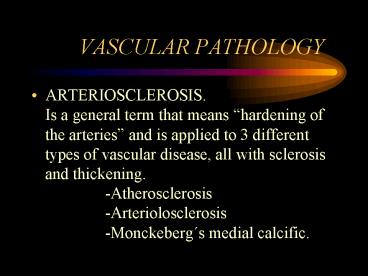VASCULAR PATHOLOGY - PowerPoint PPT Presentation
1 / 56
Title:
VASCULAR PATHOLOGY
Description:
Atherosclerotic lesions develop in the tunica intima of elastic/muscular ... of lipids macrophageslymphs.,connecti- ve tissue endotheliumbreakdown ... – PowerPoint PPT presentation
Number of Views:48
Avg rating:3.0/5.0
Title: VASCULAR PATHOLOGY
1
VASCULAR PATHOLOGY
- ARTERIOSCLEROSIS.
Is a general term that means hardening
of the arteries and is applied to 3 different
types of vascular disease, all with sclerosis and
thickening.
-Atherosclerosis
-Arteriolosclerosis
-Monckebergs
medial calcific.
2
VASCULAR PATHOLOGY
- ATHEROSCLEROSIS.
In USA about
50 or more of the annual mortality is due to
atherosclerosis
-Ischemic heart disease
-Myocardial infarction
-Stroke
-Gangrene of lower limbs
3
VASCULAR PATHOLOGY
- ATHEROSCLEROSIS...(cont.)
Pathogenesis.
Atherosclerotic
lesions develop in the tunica intima of
elastic/muscular arteries with proliferation of
smooth cellsaccumulation of lipids?macrophages,
lymphs.,connecti-
ve tissue?endothelium breakdown?plats.
deposited.
4
(No Transcript)
5
VASCULAR PATHOLOGY
6
(No Transcript)
7
(No Transcript)
8
VASCULAR PATHOLOGY
- ATHEROSCLEROSIS...(cont.)
Pathogenesis..
-Chronic endothelial injury, usually subtle
?endothelial
dysfunction?increased permeabilityleukocyte
adhesionthrombo-
tic potential.
-Accumulation of lipoproteins(LDL)in the
vessel wall
9
VASCULAR PATHOLOGY
- ATHEROSCLEROSIS...
Pathogenesis...(cont.)
-Oxidation of lipoproteins
-Adhesion of blood monocytes(and others WBCs)to
the endothelium?migration into the
intima?macrophages?foamy cells
-Adhesion of platelets
-Release of factors from activated platelets,
macrophages and
endothelial cells?migration of smooth muscle
cells from media?intima
10
(No Transcript)
11
(No Transcript)
12
VASCULAR PATHOLOGY
- ATHEROSCLEROSIS....
Pathogenesis...(cont.)
-Proliferation of smooth muscle cells
in the intimaextracellular matrix?accumulation
of collagenproteoglycans
-Increased accumulation of lipids in cells
(macrophages/smooth muscle cells) and
extracellularly.
13
VASCULAR PATHOLOGY
- ATHEROSCLEROSIS.... Risk factors
Major
Lesser,uncertain
Age
Obesity
Male gender Physical
inactivity
Family history Type A
person.
Genetic abnormalities Postmenop.estrogen
deficiency
High carbohydrate intake
NONMODIFIABLE
14
VASCULAR PATHOLOGY
- ATHEROSCLEROSIS....Risk factors...
POTENTIALLY CONTROLLABLE
Major
Lesser,uncertain
Hyperlipidemia
Alcohol
Hypertension
Lipoproteins
Cigarette smoking Transunsatur.fat int.
Diabetes
Chlamydia pneumon
15
VASCULAR PATHOLOGY
- CLINICAL HORIZON.
- Fatty dot(initial lesion) w/isolated macroph.
foamy
cells - Fatty streak(intracellular lipid accumulation)
- Fibrous cap(fibrous tissue thicker less cell
than intima) - Atheromatous plaque(20-30 yrs later)necro
tic mass of
lipidsmacroph.fibroblasts
16
(No Transcript)
17
(No Transcript)
18
(No Transcript)
19
(No Transcript)
20
(No Transcript)
21
(No Transcript)
22
VASCULAR PATHOLOGY
- CLINICAL HORIZON...(cont.)
- Complex plaque(50-60 yrs later)
-Thrombosis
within fibrous cap
-Neovascularization
-Thinning of tunica media
-Calcification
-Ulceration?thrombosis?vascular
occlusion
23
(No Transcript)
24
VASCULAR PATHOLOGY
25
VASCULAR PATHOLOGY
- ATHEROSCLEROSIS...(cont.)
Complications.
1. Acute vascular occlusion
-Myocardial
infarction(coronaries)
-Stroke (CNS) -Gangrene(lower limbs/
intestine)
2. Chronic
narrowing
-Renal hypertension
-Ischemic
atrophy of skin(diabetics)
-Kidney atrophy(unilateral)
26
(No Transcript)
27
(No Transcript)
28
(No Transcript)
29
(No Transcript)
30
(No Transcript)
31
(No Transcript)
32
(No Transcript)
33
(No Transcript)
34
(No Transcript)
35
(No Transcript)
36
VASCULAR PATHOLOGY
- ATHEROSCLEROSIS...(cont.)
Complications...
3.
Aneurysm?rupture?hemorrhage
-Abdominal aorta -Thoracic
aorta
-Iliacs -Coronaries -Basilar
-Middle
cerebral arteries -Carotids
-Popliteal
4. Embolism
-Apoplexy(carotids)
-Limb
gangrene(iliacs?popliteal)
37
VASCULAR PATHOLOGY
38
(No Transcript)
39
(No Transcript)
40
(No Transcript)
41
(No Transcript)
42
(No Transcript)
43
(No Transcript)
44
(No Transcript)
45
VASCULAR PATHOLOGY
- ARTERIOLOSCLEROSIS.
A. Hyaline arteriolosclerosis.
-Is a
homogeneous thickening of the arteriolar wall
with loss of structure narrowing of lumen.
-Hyaline material contains plasma prots.
thickened basement
membrane
-It seems that results from endothelial
damage caused by hemodynamic stress in
hypertension or metabolic disorder in diabetes.
46
VASCULAR PATHOLOGY
- ARTERIOLOSCLEROSIS...(cont.)
-There are progressive ischemic changes of
affected organs
-In kidneys?benign
nephrosclerosis assoc.
to hypertension
B. Hyperplastic arteriolosclerosis.
-Is associated with
more acute or severe increase in blood pressure
as seen in malignant hypertension.
-It appears as onion skin
concentric thickening of vessels w/narrowing of
lumen
47
(No Transcript)
48
(No Transcript)
49
(No Transcript)
50
(No Transcript)
51
VASCULAR PATHOLOGY
- Hyperplastic arteriolosclerosis...(cont.)
-In advanced
stages may be seen necrosis and deposits of
fibrinoid material in the wall
-In kidneys?malignant
nephrosclerosis associated to hypertension
-Other tissues frequently affectedperiadre--
nal fat, gallbladder, peripancreatic and
intestinal arterioles.
52
(No Transcript)
53
(No Transcript)
54
(No Transcript)
55
VASCULAR PATHOLOGY
- MONCKEBERGS MEDIAL CALCIFIC.
-Degenerative
calcification of the media of large medium
sized muscular arteries
-Occurs mainly in the elderly, but
usually does not lead to any clinical
symptomatol. -Probably
secondary to a prolonged vasotonic stimuli.
Vessels of the upper lower lims frequently
affected.
-Macro affected arteries are hard
dilated
56
(No Transcript)

